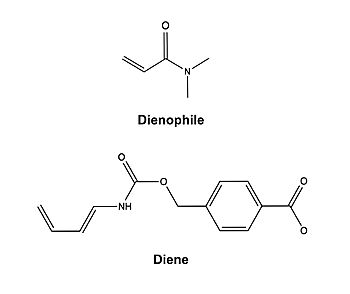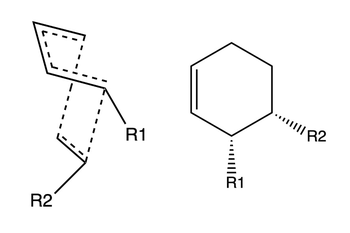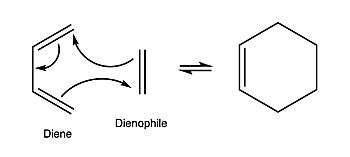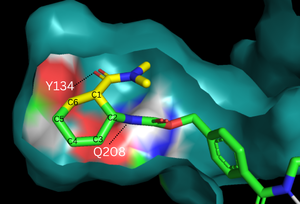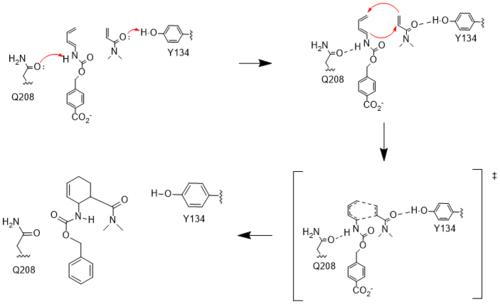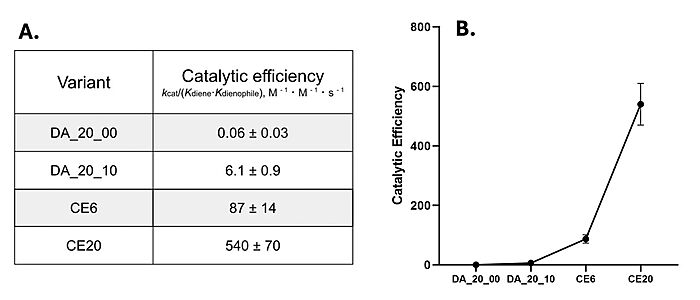Sandbox Reserved 1852
From Proteopedia
(Difference between revisions)
| Line 6: | Line 6: | ||
The Diels Alderase aims to catalyze the Diels-Alder reaction between 4-carboxybenzyl-trans-1,3-butadiene-1-carbamate and N,N-dimethylacrylamide for use in synthetic organic chemistry. Specifically, the enzyme surpasses uncatalyzed reactions by generating a product that is entirely [https://en.wikipedia.org/wiki/Stereoselectivity#:~:text=In%20chemistry%2C%20stereoselectivity%20is%20the,of%20a%20pre%2Dexisting%20one. stereoselective] for the 3R,4S endo form. The Diels-Alderase was built using ''de novo'' enzyme design, using computational modeling and refinement through collaborative problem-solving from online users. The first generation Diels-Alderase was made using the [https://en.wikipedia.org/wiki/Rosetta@home Rosetta] computational design program, where a potential active site was built and tested against a library of scaffold proteins. Later, as the active site was perfected, future generations of the Diels-Alderase were made using an online protein folding game called [https://en.wikipedia.org/wiki/Foldit Foldit,] where players competed to improve binding efficiency by completing various challenges.<ref name="Eiben"/> | The Diels Alderase aims to catalyze the Diels-Alder reaction between 4-carboxybenzyl-trans-1,3-butadiene-1-carbamate and N,N-dimethylacrylamide for use in synthetic organic chemistry. Specifically, the enzyme surpasses uncatalyzed reactions by generating a product that is entirely [https://en.wikipedia.org/wiki/Stereoselectivity#:~:text=In%20chemistry%2C%20stereoselectivity%20is%20the,of%20a%20pre%2Dexisting%20one. stereoselective] for the 3R,4S endo form. The Diels-Alderase was built using ''de novo'' enzyme design, using computational modeling and refinement through collaborative problem-solving from online users. The first generation Diels-Alderase was made using the [https://en.wikipedia.org/wiki/Rosetta@home Rosetta] computational design program, where a potential active site was built and tested against a library of scaffold proteins. Later, as the active site was perfected, future generations of the Diels-Alderase were made using an online protein folding game called [https://en.wikipedia.org/wiki/Foldit Foldit,] where players competed to improve binding efficiency by completing various challenges.<ref name="Eiben"/> | ||
| - | [[Image: | + | [[Image:Dielsalderasesubstrates.jpeg|350px|left|thumb|Figure 1. Diels-Alderase substrates. Diene is 4-carboxybenzyl trans-1,3-butadiene-1-carbamate; dienophile is N,N- dimethylacrylamide.]] |
The Diels-Alderase was designed to connect a diene and dienophile in a [https://en.wikipedia.org/wiki/Diels%E2%80%93Alder_reaction Diels-Alder reaction.] It accomplishes this by decreasing the energy gap between the dienophile’s lowest unoccupied molecular orbital [https://en.wikipedia.org/wiki/HOMO_and_LUMO (LUMO)] and the diene’s highest occupied molecular orbital [https://en.wikipedia.org/wiki/HOMO_and_LUMO (HOMO)] in the transition state.<ref name="Siegel">PMID:20647463</ref> The current most active form of the Diels-Alderase is modelled under the PDB code [https://www.rcsb.org/structure/4O5T 4o5t]. | The Diels-Alderase was designed to connect a diene and dienophile in a [https://en.wikipedia.org/wiki/Diels%E2%80%93Alder_reaction Diels-Alder reaction.] It accomplishes this by decreasing the energy gap between the dienophile’s lowest unoccupied molecular orbital [https://en.wikipedia.org/wiki/HOMO_and_LUMO (LUMO)] and the diene’s highest occupied molecular orbital [https://en.wikipedia.org/wiki/HOMO_and_LUMO (HOMO)] in the transition state.<ref name="Siegel">PMID:20647463</ref> The current most active form of the Diels-Alderase is modelled under the PDB code [https://www.rcsb.org/structure/4O5T 4o5t]. | ||
| + | [[Image:DAstereoselectivity.png|350px|left|thumb|Figure.x]] | ||
| + | [[Image:SampleDAmech.jpeg|350px|right|thumb|Figure X.]] | ||
The binding pocket of 4o5t is selective for two substrates, 4-carboxybenzyl trans-1,3-butadiene-1-carbamate ([https://en.wikipedia.org/wiki/Diene diene]) and N,N- dimethylacrylamide (dienophile). These substrates are shown as a single, combined ligand–name—in the protein model. The binding site contains a [https://en.wikipedia.org/wiki/Hydrogen_bond hydrogen bond] donor (Tyr134) which lowers the LUMO energy and stabilizes the negative charge on the dienophile and a hydrogen bond acceptor (Glu208) that increases the HOMO energy and stabilizes the positive charge on the diene.<ref name="Siegel"/> Both of these H-bonding interactions work to stabilize the transition state, while also orienting the substrates in optimal conformations for reacting. | The binding pocket of 4o5t is selective for two substrates, 4-carboxybenzyl trans-1,3-butadiene-1-carbamate ([https://en.wikipedia.org/wiki/Diene diene]) and N,N- dimethylacrylamide (dienophile). These substrates are shown as a single, combined ligand–name—in the protein model. The binding site contains a [https://en.wikipedia.org/wiki/Hydrogen_bond hydrogen bond] donor (Tyr134) which lowers the LUMO energy and stabilizes the negative charge on the dienophile and a hydrogen bond acceptor (Glu208) that increases the HOMO energy and stabilizes the positive charge on the diene.<ref name="Siegel"/> Both of these H-bonding interactions work to stabilize the transition state, while also orienting the substrates in optimal conformations for reacting. | ||
Revision as of 23:46, 27 April 2025
| This Sandbox is Reserved from March 18 through September 1, 2025 for use in the course CH462 Biochemistry II taught by R. Jeremy Johnson and Mark Macbeth at the Butler University, Indianapolis, USA. This reservation includes Sandbox Reserved 1828 through Sandbox Reserved 1846. |
To get started:
More help: Help:Editing |
Diels-Alderase
| |||||||||||
